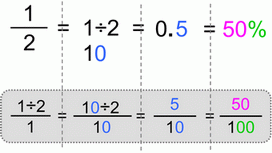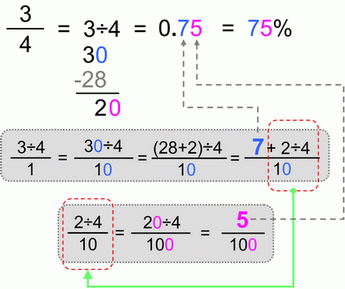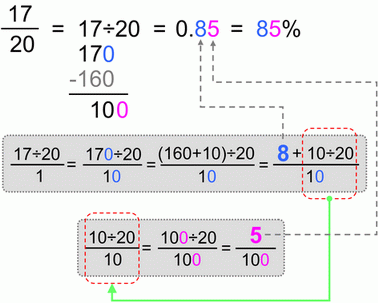|
Convert
|
||||||||||||||||||||||||||||||||||||||||||||||||||||||||||||||||||||||||||||||||||||||||||||||||||||||||||||||||||||||||||||||||||
|
So our converting process would be: |
Well, as I’ve said before, decimal numbers are a special form of fractions. We know that decimal numbers are a way of representing whole numbers and its parts in 10ths, 100ths, 1000ths etc (i.e. in 10 based system).
Having said that, percents are fractions with denominator = 100. So, with percents, we’re dealing with 100ths only. Or if we want to say it in decimal terms: only two decimal places after the decimal point count as percents (the rest would be its fraction parts).
Know this: every percent can be represented as a fraction, and vice versa.
Since talk without examples is obscure, let’s offer some convert fraction to percent examples. :-)
We’ll start with:
Fraction – Fraction 100ths – Percent
Conversion
Check out this very easy, but illustrative example:
 |
= |
 |
= |
 |
||||||
| 1 | ×5 | = | 5 |
= 0.5 |
= | 50 |
= 50% |
|||
| 2 | ×5 | 10 | 100 | |||||||
| Fraction | Decimal | Percent | ||||||||
In this particular case, we found a way to get 10ths, and 100ths by expanding of fractions.
As you can see above – these are all fractions. The sizes of parts (denominators) are different, but still fractions. And yet the first one is a regular fraction, the second one is a decimal fraction, and the third one is represented as a percent fraction.
Their total values are the same, so these fractions are also equivalent.
We can also see that regular fractions have no "restrictions" concerning denominators, while decimals are "restricted" to 10s (100s, 1000s etc), and percents nailed to 100ths only (btw, 1$ = 100 cents, so per-cents are 100ths). :-)
Let’s see an another example how to convert fraction to percent.
 |
= |
 |
||||
| 3 | ×25 | = | 75 | = 0.75 | = 75% | |
| 4 | ×25 | 100 | ||||
| Fraction | Decimal | Percent | ||||
In this case we got 100ths right away and there was our percent. Let me repeat, the first two decimal places after the decimal point represent percents.
In this third example let’s have 17/20. Don't let 17 scare you, we’re only interested in getting the 100ths in the denominator – so we expand our 20ths by 5. Since we got our 100ths – our percent is the numerator = 85.
 |
= |
 |
||||
| 17 | ×5 | = | 85 | = 0.85 | = 85% | |
| 20 | ×5 | 100 | ||||
| Fraction | Decimal | Percent | ||||
|
Useful digression:
| ||||||||||||||||||||||||||||
Now let’s look at those 3 cases from another perspective:
Fraction – Decimal (2 places) – Percent
Conversion
This is classic division, regular division of whole numbers.
|

|
Now let’s see example number 2.
|

|
And finally example number 3.
|

|
So, that should be enough for starters. Again, if you’d like more convert fraction to percent examples – let me know. Although it would probably be more wise if I’d create some convert fraction to percent worksheets... Bye, bye. Don’t be a stranger. :-)
|
Go from Convert Fraction to Percent to Math Help With Fractions Go from Convert Fraction to Percent to Free Math Help Online - Home Page |





